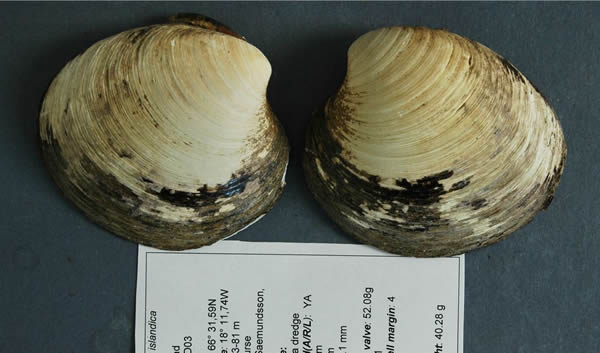Oldest Clam Consternation Overblown
Shell valves from a specimen of Arctica islandica that was found to have lived for approximately 507 years are pictured here. The creature's death has generated some consternation about marine researchers that looks a bit overblown.
Consternation over the death of the world's oldest-recorded animal, a 507-year-old clam nicknamed Ming, has earned marine researchers unhappy headlines worldwide.
But a closer look at the story—"Clam-gate," as the BBC called it—finds the tempest over Ming a bit overblown.
News of the clam's death, first noted in 2007, took on a life of its own this week after researchers led by James Scourse, from the United Kingdom's Bangor University, reanalyzed its age and announced the 507-year estimate.
Contrary to news reports, the researchers say they did not kill the elderly clam for the ironic-seeming purpose of finding out its age.
"This particular animal was one of about 200 that were collected live from the Icelandic shelf in 2006," explains climate scientist Paul Butler from the same U.K. university, who, along with Scourse, dredged up the clam as part of a research project to investigate climate change over the past thousand years.
All 200 clams were killed when they were frozen on board to take them home. They didn't find out how old Ming was until they were back in the lab and looked at its shell under a microscope.
Ming Dynasty Survivor
When Ming first made headlines in 2007, the researchers said they thought it was about 405 years old, earning it even then the title of the oldest-known animal.
After the more recent reanalysis, they realized that the bivalve was even more impressive than they had thought.
In the year Ming was born, Leonardo da Vinci was at work on the "Mona Lisa," the first recorded epidemic of smallpox hit the New World, and the Ming dynasty ruled China (hence the name). Ming was 52 years old when Queen Elizabeth I took the throne.
Clam Age Counting
The researchers determined Ming's age by counting the number of bands in its shell. This type of clam, the ocean quahog, grows a new band every year.
The 100-year age discrepancy resulted from the 2007 analysis examining a part of Ming's shell where some of the bands were so narrow they couldn't be separated from each other.
Scourse, a marine geologist, says that the new age has been verified against radiocarbon dating and is "pretty much without error."
Clams Don't Carry Birth Certificates
When Scourse and Butler dredged up the live clam, they had what appeared to be an everyday quahog, an animal that could fit into the palm of their hand.
As Madelyn Mette, a Ph.D. student at Iowa State University in Ames who also studies these clams, explains, "Once they reach a certain age, they don't get a lot bigger per year … If you have a large clam, you can't always tell if it's 100 years old or 300 years old, because there's very little difference in size."
Scourse points out that the 200 clams they sampled represented a very small fraction of the world's entire clam population. For that reason, even if Ming was the oldest animal that we knew, the chances that it was actually the oldest quahog out there in the ocean depths are "infinitesimally small."
How About Some Chowdah?
In fact, it isn't unthinkable that someone might eat a clam of Ming's age for lunch—ocean quahogs from the North Atlantic are one of the main species used in clam chowder.
If nothing else, Ming's sacrifice should help out Scourse and Butler's research, looking at long-term climate impacts on sea life over the past few centuries.
"The 507-year-old is at the top end of the series," Scourse says. "From this we can get annual records of marine climate change, which so far we've never been able to get from the North Atlantic."
By Samantha Larson
for National Geographic
Published November 16, 2013












